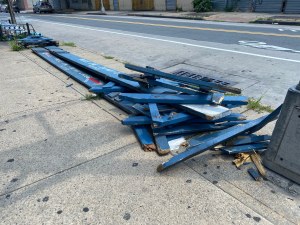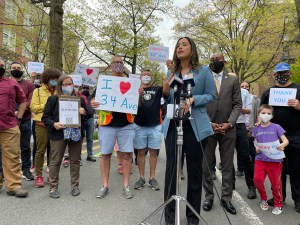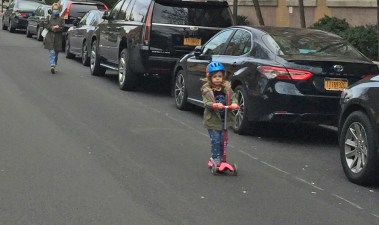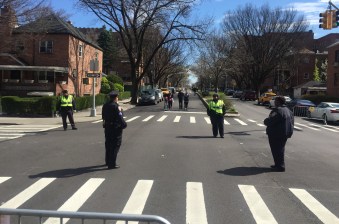Analysis: De Blasio’s Open Streets Program Has Failed
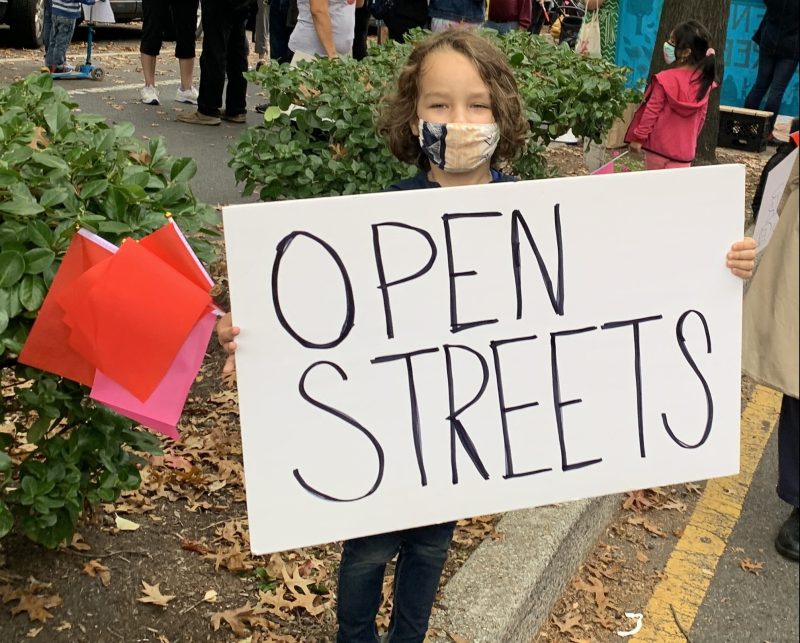
The de Blasio Administration’s open streets program is a Tale of Two Cities, with a majority of streets already reclaimed by car drivers, massive inequity in the distribution of open streets, and the entire undertaking serving far too few New Yorkers, a new report shows.
Transportation Alternatives sent surveyors out to every open street in the city listed on the Department of Transportation website — and they came back with a report showing that more than a year into the program, only 126 out of 274 streets were functioning as “open” (and TA’s definition was quite charitable: the presence of a single barricade qualified).
Worse, despite a promise by the de Blasio administration early in the pandemic to create 100 miles of open streets, the city currently has only 23.89 miles of active open streets — not even one-quarter of what was originally proposed. And the mayor also failed on his promise to bring open space to the neighborhoods that need it most: There are zero active open streets in the six community districts that have the fewest residents living within walking distance of a park, the report stated.
Perhaps the most glaring problem with the open streets program is the lack of equity: A whopping 84 percent of open streets in the Bronx and 69 percent in Queens were non-operational. And open streets in Black and Latino neighborhoods were much more likely to lack useful barriers and, as such, become much more inviting to drivers.
Only 20 percent of New Yorkers live within walking distance of an active open street, the survey revealed. But roughly 31,000 people live within walking distance of the average listed open street — meaning if the city would merely elevate the quality of all its open streets, it “has the potential to impact a small town’s worth of people at every single listed open street,” the report said.
“TA hoped that the open streets program would correct existing inequities in access to parkland and greenspace,” the report added. “Unfortunately, this has not occurred.”
In other findings:
- Open streets in the Bronx and Brooklyn were graded worse than the citywide average across the five boroughs. On a scale of 10 based on how many attributes an open street had, the average open street in the Bronx got 2.0 out of 10 and the Brooklyn average was just 4.1 (the citywide average was 4.3).
- Income plays a factor: Households with an income under $50,000 are significantly more likely to live near a low-rated open street while households with an income over $100,000 are significantly more likely to live near a high-rated open street. Households with an income of $200,000 or more were more than twice as likely to live within walking distance of a high-rated open street than a low-rated one, the report said.
- The streets that are considered active had much better ratings: Active streets in Queens and the Bronx were rated 7.3 and 5.7 respectively, but the total active open street mileage was just 6.3 miles for Queens and .53 miles for the Bronx.
- Even though Manhattan and Brooklyn combine for 48 percent of the city’s population, the boroughs combined to have 66 percent of the active open streets.
What went wrong?
Per the report, non-active open streets have two major problems. One is that residents of areas where open streets are listed but don’t work see the program as a broken promise instead of a beloved lifeline. The other is that since open streets are shared on services like Google Maps whether they’re active or not, drivers come to think they can drive unencumbered on any open street they encounter.
The distribution of highly rated open streets was impacted by both racial and economic disparities, as a Streetsblog analysis also showed in the summer of 2020. Any listed open street, whether active or inactive, was more likely to be found in a wealthy neighborhood than a poor one. Every income band lower than $75,000 was more like to be within walking distance of a low-rated open street than a highly rated one. Open streets in White neighborhoods were also more likely to be highly rated than open streets in majority Black, Latino or low-income neighborhoods.
The low ratings meant that open streets in Black, Latino and low-income neighborhoods were essentially non-functional as a program. Drivers were far more likely to drive on open streets with no barriers, a hallmark of low-rated open streets, which also meant actual car-free streets were much more likely to be in White neighborhoods. Open streets within walking distance of supermajority White neighborhoods were four times as likely to be car-free for the first five minutes of observation by a surveyor than an open street within walking distance of a majority Black neighborhood.
Crucially, the report suggests the de Blasio administration’s planning process betrayed any equity concerns from the start of the open streets program. Despite the fact that Bronx has the highest asthma rates in the city and Staten Island has the least amount of bike infrastructure in the city, neither borough got anywhere near the amount of planned open streets from the city. Where Manhattan has 102 open streets assigned to it, the Bronx only was given 31 and Staten Island was given nine.
On the plus side
As Streetsblog previously reported, open streets were much safer for pedestrians, cyclists and drivers than other streets. Comparing the 12 months before the coronavirus pandemic with the 12 months since the start of the city’s open streets program in April 2020, Transportation Alternatives found that pedestrian and motorist injuries both decreased at a faster rate on open street than on other streets, 38 versus 42 percent for pedestrians and 25 and 50 percent for motorists. Additionally, while cyclist injuries rose 20 percent across the city in that time frame, they dropped 17 percent on open streets.
Additionally, the report found that where open streets work, people truly enjoy them — and not only on thronged open streets such as Vanderbilt Avenue in Brooklyn or 34th Avenue in Queens, but also on smaller open streets with active volunteer groups.
In Morrisania in the Bronx, Lonnie Hardy established a small open street on Jennings Street between Prospect Avenue and Chisholm Street. Hardy, who got funding from the city and various sponsors from around the city, ran her open street from from 11 a.m. to 7 p.m. on weekdays this summer through Oct. 1, when she said it ran out of funding. With a focus primarily on providing children’s programming, Hardy, some neighbors and some youth workers she funded when she had city funding provided the street with children’s recreational activities, arts and crafts and even budgeting and resume building lessons for older kids.
“There should be open streets, not just on 34th Avenue or in SoHo,” Hardy said. “Especially during the summer months, who wants to be cooped up in a community center, when you can go outside and enjoy the flowers?”
Hardy said she had to stop running the open street when her small city funding ran out.
“If you put the money into the children, you won’t have to worry about incarceration … because they have something productive to do,” she said. “We have a couple of people in the neighborhood that are very handy, and we were going to have children learn to sand and stain benches, so that they can learn how to do that. We can fix bicycles, so they will know the difference between a flathead screwdriver and a Phillips head.”
There are lots of New Yorkers like Hardy who want an increase in open streets. According to a Data for Progress poll commissioned by Streetsblog earlier this year, 67 percent of voters approved of the program in general, and an even higher amount prefer it over parking spaces.

The report shows that open streets work best when they require drivers to physically move barriers to travel down a street. In such cases, an average of only one car travel down an open street street during five minutes of observation, something backed up by previous reporting showing that open streets with multiple barriers at each intersection where more effective at keeping cars out.
When open streets were secured with barricades that drivers could maneuver around without getting out of their car, observers saw five cars on average per five minutes of observation, and surveyors saw 10 cars in five minutes of observation on open streets with no barriers at all.

What is to be done now?
First, make the permanent open streets program truly permanent.
“Open streets are a critical tool for reclaiming streets from cars and returning them to people,” the report concludes. “The city should immediately make every open street permanent, 24/7, open space which is made predominantly or entirely car-free by using durable infrastructure to limit and discourage car-access, and where car-access is permitted, to reduce vehicle speeds to five miles per hour.”
To get there, the city must deploy permanent infrastructure, something that has become a rallying cry on 34th Avenue where open streets stewards have asked for a linear park. The permanent design could also help remove the belief in some quarters of the city that the program is only temporary, a belief that has fueled physical abuse of open streets volunteers and verbal abuse of Department of Transportation employees.
On the street design front, the report suggests looking to places like Denmark, Philadelphia and Washington, where local governments have installed a type of street known as a woonerf, a shared space design that calms traffic and makes streets more accessible to wheelchair users since they have more than just a single curb cut at a corner.
Such streets can feature chicanes or pinch points to slow down traffic on an open street or bioswales to cut down on street flooding.

The report recommends the city use bollards, boulders and other permanent installations to communicate the permanent nature of open streets rather than the French barricades and plastic barricades that drivers can easily move out of the way or get around. If an open street is only part-time, the report still recommends switching to more solid barriers, such as planters on wheels, which can be easily moved by volunteers and also provide extra greenery for a neighborhood.
Open street segments should also be longer, the report said.
“Longer open streets were consistently rated higher by surveyors,” it reads. “Longer open streets also add more functionality: creating public space for recreation while also acting as a safe addition to the bike network.”
How to make it equitable
The failure of the open streets program to be truly equitable was easily predictable for a program based entirely on volunteer labor, which is easier to scare up in wealthier or work-from-home neighborhoods. When the open street program began, then-DOT Commissioner Polly Trottenberg vowed to make sure the program did not end up being the playground of the rich.
“Neighborhoods,” she said, “where we think we really need to do this [for equity sake], but maybe there isn’t a local partner, those may be places where you will see more city staff stepping in to make sure it will happen.” [It did not, in fact, happen.]
So in order to make the program more equitable, the report suggests that the city move away from the volunteer-based expectation for a successful open street and run the streets itself. For open streets that the city doesn’t run itself, the report suggests city funding to local businesses, community organizations or residents to care of moving barriers or picking up litter that tends to accumulate whenever more people are using public space.
“Open streets are inequitable because New York City is inequitable,” the report said. “If an open streets program relies on volunteer support, then open streets will be better in neighborhoods where residents are rich in free time and worse in those without such luxuries.” As such, the city “should aggressively fund open streets with equity as a focus, targeting and distributing resources to the neighborhoods with the greatest need.”
The report said it would be up the DOT to determine that need based on the safety, reduced pollution and climate benefits open streets can provide. This would require an audit of infrastructure “that tracks historic and modern spending on city streets by neighborhood, overlaid with rates of speeding, traffic violence, asthma, air quality, and access to green space.”
A spokesperson for the DOT said that the agency would review the findings from the report, and defended the way the program has gone from emergency fix to something more permanent in the future.
“Open streets were an emergency response to the pandemic, and now we are taking the necessary steps to make this program permanent and sustainable in the long term,” said agency spokesperson Seth Stein. “Neighborhoods that applied to the program are already being supported with resources to make their beloved Open Streets permanent. In addition, equity and fairness have been central to this program from the start, and we are doing outreach to neighborhoods that lack community groups or BIDs so they get the support necessary to take part in the program no matter what. We look forward to reviewing this report and any recommendations to make this already successful program even better.”
